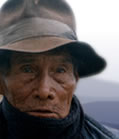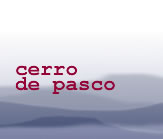THEMES IN THIS
TESTIMONY
Agriculture

Community Activities

Compensation

Conflict

Development

Employment and Income

Environment

Health

History

Identity

Industry

Justice and crime

Land

Livestock

Migration

Social Change

Click on arrows
to find more
testimonies
featuring
these themes
|
|
Sex
|
male
|
|
|
Age
|
33
|
|
|
Occupation
|
teacher
|
|
|
Location
|
Quiulacocha
|
|
|
Date
|
1995
|
|
summary
Héctor studied outside Quiulacocha but returned to be near his family and to teach what he'd learnt to the people of his community. He discusses the differences between city and campesino life, preferring the latter because of the tranquillity and solidarity of the people. He explains how the presence of the mines, which only benefit the owners, the government and the workers, has changed the community. Once people start working for the mines, they develop a different mindset, and are disinclined to challenge the company (which he recognises is understandable). Yet the resulting pollution has meant a change in productive activities, has affected the health of people and livestock, and is one of the reasons why young people want to leave the community.
He talks about the conflicts with Centromin and ways in which the problem of pollution of the lakes may be solved. He feels strongly about the lack of support from the government, and how little notice they have taken of the community's project proposals; he discusses the ways in which the community itself is trying to overcome the problems by setting up small businesses. Although none of his answers are particularly detailed, it’s still a good interview.
detailed breakdown
|
You will need a password from Panos to view the full
transcript of the interview. To apply for a password, click here.
Once you have a password, click here to go to the beginning
of the transcript. You can also click on any section of the
breakdown of content below and go straight to the
corresponding part of the transcript.
|
| Section 1 |
Although most young people emigrate he wanted to stay, preferring country life: city life is too fast, nobody helps each other, too much crime, too expensive whereas there is solidarity in community.
Being a comunero (registered community member with rights and responsibilities) is to have land and cattle and to do communal work
|
| Section 2 |
Normally comuneros are children of other comuneros or have inherited land, and are rarely outsiders - but this is changing now more people are marrying from outside the community. Customs too are changing: before people fished and raised livestock; but the presence of miners has changed community.
History – goes back to Incas. Name = Quiula - seagull, cocha – lake. Sadly, refers to two things that hardly exist anymore.
|
| Section 3 |
Organisational structure of the community and conflict resolution. Cites how they tried diplomacy with Centromin but got nowhere and decided to fight head on. Says mines have harmed the community (and prompted migration)
|
| Section 4 |
Migration: people leave for work, because they haven’t got land; don't usually return except to visit for a festival or because as a comunero, there remain some benefits for them.
Services in community - medical post, water, drainage, light, but no phones. Some problems with neighbouring communities’ invasion of land
|
| Section 5 |
Trying to recover this land - need room for cattle. “Since the arrival of the Spanish, since the arrival of the gringos (North Americans who ran/owned the mines) and their huge mining companies, my community, our communities, have continually lost their land, whether it be through pillage or expropriation.” No help from govt - reject project proposals. By the time council funds filter down to them it’s “the dregs”
|
| Section 6 |
Claims military presence isn't a problem.
Occupations: cattle rearing, public sector, mining. Miners do contribute a little through communal work, but generally they have different priorities. Claims it is in the company’s interests that the community should be divided in this way.
|
| Section 7 |
Miners are being laid off – but “it’s like they’ve been brainwashed” and they aren't the same; don't usually want to go back to what they did before.
Other employment available: selling meat, washing clothes, extracting sand. Want to grow maca (kind of tuber) but don't have the technology or advice.
|
| Section 8 |
Pollution of lakes getting worse: company built water recycling plant but pipe burst and contaminated lakes further. No more fishing; edible birds have also disappeared.
Have looms for wool, but again lack technical advice and support.
|
| Section 9 |
Similarly, trying to develop clothing industry but machines too old. Have started a bakery to supply bread to Quiulacocha and other communities.
Effects of polluted air and water; increased rate of TB and silicosis. Dust from the unpaved road is another problem, they’re on a key transport route.
|
| Section 10-11 |
Describes action taken to illustrate levels of pollution – nothing happened. Don't have money to take Centromin to court. Have stood up to them but then Centromin breaks promises for sports complex etc. Have offered to move the community but “these lands are the inheritance we’ve received from our ancestors, we don't want to lose them for anything. We want to recover from the pollution and preserve what is left of our customs. We're a working community, with a history, and this is what we want to leave our children.”
|
| Section 12 |
When gringos owned mines they “knew how to win the confidence of our village, of our people simply by being nice, by their ability to teach, under the guise of being able to do anything…. but gave nothing in return.”
Nationalisation was right (at least profits belong to Peru) but didn't improve things really as national staff lacked expertise.
Community is close to a crisis: unemployment, pollution
|
| Section 13 |
Cultural aspects – younger people do know about history but they're different, “more alive, more awake” , influenced by TV and city life. Recites words from song about contamination
|
| Section 14-15 |
Sees future in small industries and school. Community aspiration is peace. Proposes that lake is filled with soil and trees grown on it to get rid of contamination; that roads are paved to get rid of dust; that government takes notice of their project proposals |
|


